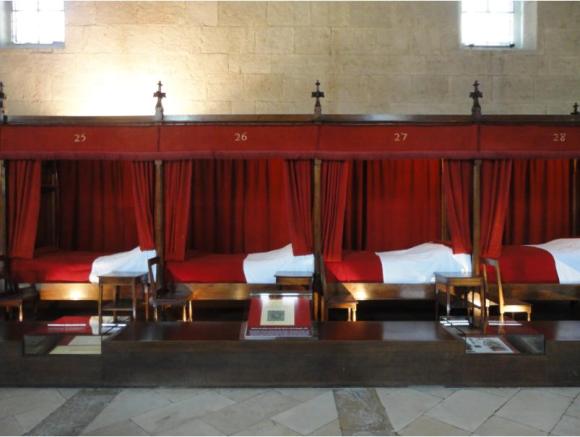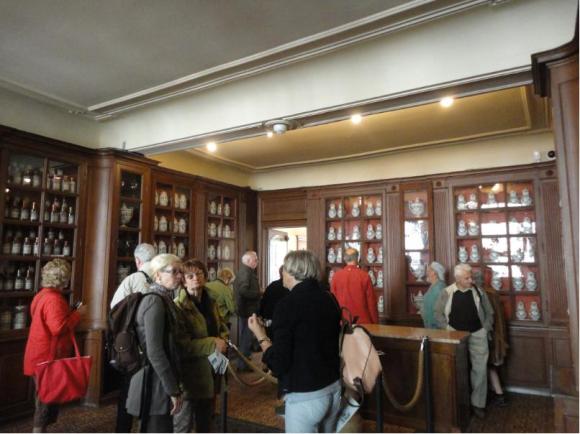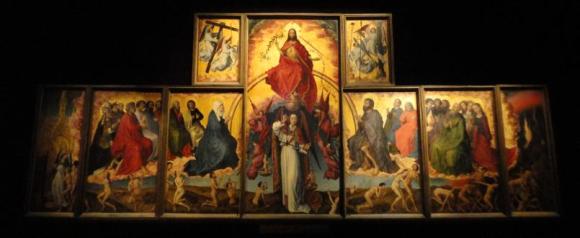Beaune, Beaune, Beaune. A charming little French town with a population of around 23,000 famous for two things. First is the wine (Beaune is the capital of the Burgundy wine region) and second is the Hôtel Dieu, also known as Les Hospices de Beaune. I’m going to tell you about the Hospices de Beaune first though, because it’s something that resonates highly with me. Simply put, the Hospices de Beaune is a hospital.
Built in 1443 by Nicolas Rolin, the Chancellor to Duke Philippe-le-Bon of Burgundy, the hospital was built as a charity work and as a “palace for the poor.” During this time, Beaune was not the prosperous city it is today. There was famine; there was abundant poverty. Around 75% of the townspeople did not have supplies. So Rolin and his wife, Guigone de Salins, decided to found a Hospice for les Pôvres (the Poor). Nicolas and Guigone gave the Hospices a generous endowment of vines and a saltworks, and hired a ton of artists to decorate the Hospice.
 These artists clearly did something right, for today this hospital is still renowned for its famous Court of Honour and the rooftops surrounding the Court.
These artists clearly did something right, for today this hospital is still renowned for its famous Court of Honour and the rooftops surrounding the Court.
 Historians think that these glazed multicolored tiles came somewhere from Central Europe. The tiles are set in geometric patterns; inset in the roofs are gable windows with carvings and lead decorations.
Historians think that these glazed multicolored tiles came somewhere from Central Europe. The tiles are set in geometric patterns; inset in the roofs are gable windows with carvings and lead decorations.
 There is such a contrast between the brightness of these tiles and the “warmer” colors of the timber, clay, stone, and slate used to build the actual wings of the hospital. Ever since this courtyard was built, it has been the inspiration for many Burgundian roofs.
There is such a contrast between the brightness of these tiles and the “warmer” colors of the timber, clay, stone, and slate used to build the actual wings of the hospital. Ever since this courtyard was built, it has been the inspiration for many Burgundian roofs.
I really liked the colors.
 So, from the time of its creation to the 20th century, many, many patients were treated at Les Hospices de Beaune by the Sisters of the Hospices de Beaune. The hospital’s reputation spread and it was dubbed as the Palace of the Poor. People donated money, art, and even hospitals in nearby Pommard, Volnay, and Meursault (to be further discussed another day…) donated vineyards. Today, the Hospices owns around 61 hectacres of vineyards in the region. In 1971 the medical activities of the hospital were transfered to a more modern hospital, but it remains a retirement home today. Every year, the Hospices organize the most famous wine auction in the world. Of course, the money goes back to the hospital.
So, from the time of its creation to the 20th century, many, many patients were treated at Les Hospices de Beaune by the Sisters of the Hospices de Beaune. The hospital’s reputation spread and it was dubbed as the Palace of the Poor. People donated money, art, and even hospitals in nearby Pommard, Volnay, and Meursault (to be further discussed another day…) donated vineyards. Today, the Hospices owns around 61 hectacres of vineyards in the region. In 1971 the medical activities of the hospital were transfered to a more modern hospital, but it remains a retirement home today. Every year, the Hospices organize the most famous wine auction in the world. Of course, the money goes back to the hospital.
Let me tell you a little about the actual structure of Les Hospices de Beaune. Most important is the Grand Hall des Pôvres, which was the center of the hospital and had beds, tables, and benches for the patients.
 The beds looked so comfortable I kind of wanted to snuggle into the covers (ok, so I was there at 9:30 am on a Saturday morning, cut me some slack). But back in the day, there were chests behind each bed to keep the patients’ clothes.
The beds looked so comfortable I kind of wanted to snuggle into the covers (ok, so I was there at 9:30 am on a Saturday morning, cut me some slack). But back in the day, there were chests behind each bed to keep the patients’ clothes.
 There’s also a chapel, rooms to separate patients who were merely sick from those who were dying, a kitchen, a pharmacy. Photos are below with small descriptions.
There’s also a chapel, rooms to separate patients who were merely sick from those who were dying, a kitchen, a pharmacy. Photos are below with small descriptions.
Chapel – it’s an integral part of the Hall of Pôvres and represents the alliance between the religious and medical practices taking place in the Hospices. There used to beo one amazing work of art here, a 15th century Polyptych attributed to the Flemish artist Roger Van de Weyden. Depicting the Last Judgement, the polyptych was placed above the alter in the chapel but could only be seen by the sick on Sundays and feast days. Nowadays the polyptych is kept in another room in the hospital to prevent wear and tear.
Saint Hugues Room – This room was created in 1645 as a room dedicated to the sick. Nine of the eleven wall paintings were done by the Parisian painter Issac Moillon to illustrate the miracles of Christ. The other 2 paintings depict St. Hugues.
 Saint Nicholas Room – This room was designed to take in the “poor and sick in danger of dying.” It only had 12 beds, originally for both men and women. But when Louis XIV visited in 1658 he was shocked at this and set up an annuity of 500 pounds for new arrangements to separate the men from the women.
Saint Nicholas Room – This room was designed to take in the “poor and sick in danger of dying.” It only had 12 beds, originally for both men and women. But when Louis XIV visited in 1658 he was shocked at this and set up an annuity of 500 pounds for new arrangements to separate the men from the women.
 Kitchen – the kitchen was actually used until 1985 to feed the residents of the retirement home, but since then it has been restored to its appearance in the beginning of the 20th century. There’s a huge dual-hearth Gothic fireplace, but the star of the show is definitely the steel spit, made in 1698. It is turned by a little robot called Maître Bertrand that is decorated with a traditional French uniform (see bottom right, below).
Kitchen – the kitchen was actually used until 1985 to feed the residents of the retirement home, but since then it has been restored to its appearance in the beginning of the 20th century. There’s a huge dual-hearth Gothic fireplace, but the star of the show is definitely the steel spit, made in 1698. It is turned by a little robot called Maître Bertrand that is decorated with a traditional French uniform (see bottom right, below).
 Pharmacy – each hospital in the Middle Ages had its own pharmacy since there were no big pharmaceutical companies to organize medicine production!
Pharmacy – each hospital in the Middle Ages had its own pharmacy since there were no big pharmaceutical companies to organize medicine production!
 Today, les Hospices are perfectly preserved as an architectural jewel of the middle ages. I was touched as I walked through the hospital…isn’t it truly magnificent what big dreams can do? I don’t think I’ve ever explicitly mentioned on this blog what I’ll be doing once I leave Europe. Well, my summer plans will be the subject of another post, but for the next 4 academic years I’ll be hitting the books again as a medical student. Les Hospices de Beaune were an inspiration to me because I can only dream that one day I’ll be able to make as much of a difference in the lives of patients as Nicolas Rolin and Guigone de Salins did, 600 years ago. Even as medicine was pretty primitive back then, the idea that people in the middle of wine country would donate their vineyards to this hospital gives me hope that the world has been, and will continue to be, a good place.
Today, les Hospices are perfectly preserved as an architectural jewel of the middle ages. I was touched as I walked through the hospital…isn’t it truly magnificent what big dreams can do? I don’t think I’ve ever explicitly mentioned on this blog what I’ll be doing once I leave Europe. Well, my summer plans will be the subject of another post, but for the next 4 academic years I’ll be hitting the books again as a medical student. Les Hospices de Beaune were an inspiration to me because I can only dream that one day I’ll be able to make as much of a difference in the lives of patients as Nicolas Rolin and Guigone de Salins did, 600 years ago. Even as medicine was pretty primitive back then, the idea that people in the middle of wine country would donate their vineyards to this hospital gives me hope that the world has been, and will continue to be, a good place.



what a gem! love the roof. this is too cool.